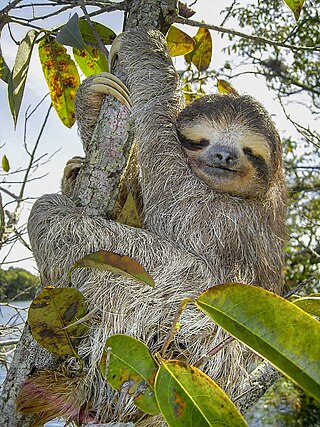Ecological Roles of Sloths
Sloths play an essential part in maintaining the ecological balance in tropical jungles. Their slow movement and arboreal nature reduce their energy requirements, allowing them to survive on a low-calorie diet primarily made up of leaves.
They contribute to the rainforest ecology by facilitating tree growth and serving as hosts to a variety of organisms that live in their fur, creating micro-ecosystems.
- Tree growth facilitation
- Host micro-ecosystems
- Low-calorie diet adaptation
- Energy-efficient lifestyle
Comparison Between Types of Sloths
Physical Differences
There are several defining physical differences between three-toed and two-toed sloths:
- Number of claws: Three on the forelimbs for three-toed, two for two-toed.
- Body size: Sloths vary between approximately 58-70 cm and can weigh between 4-9 kg.
- Tail: Three-toed sloths have a short tail of 2–9 cm, while two-toed lack tails.
- Unique to sloths is also their 8 to 9 neck vertebrae, allowing them to turn their heads up to 270 degrees.
Lifestyle and Behavior
Sloths have different lifestyles and behaviors adapted to their specific habitats:
- They are mostly nocturnal and spend a lot of their time hanging from trees.
- Their life patterns include a solitary lifestyle and slow movement, which helps them conserve energy.
- They sleep up to 19 hours a day, which is crucial for their low metabolism.
- Their diet is mainly plant-based, including leaves and twigs that they need to digest carefully.
Conservation and Threats
Threats to Sloths
Despite their unique adaptations, sloths face several serious threats:
- Habitat loss due to deforestation and the expansion of agriculture.
- Climate change affects their habitats and food availability.
- Human impact through hunting and illegal trade also threatens their populations.
Conservation Programs
There are several conservation initiatives aimed at protecting sloths and their habitats:
- Protected areas to preserve natural habitats.
- Educational programs that inform the public about the importance of these animals.
- Organizations working with rehabilitation and care of injured populations.
Conclusion
By understanding the different types of sloths, their differences, adaptations, and the threats they face, we can appreciate the importance of preserving these unique animal species. Sloths are not only symbols of our tropical rainforests but also crucial for the ecological balance in their habitats. We must all contribute to conservation efforts to ensure their survival for future generations.


